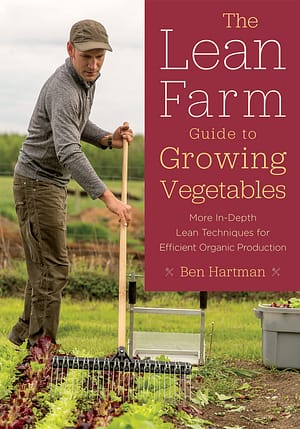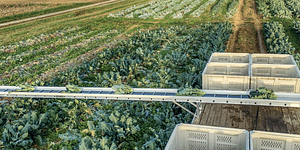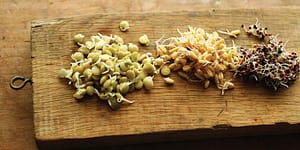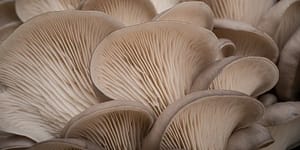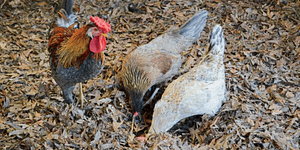5 Steps to Achieve A Lean Vegetable Farm

Looking to create a lean vegetable farm? The lean system, designed to cut out waste and increase profits, allows you to operate a successful and healthy farm with a fraction of the work it usually takes. Here are five simple steps to help you get started!
Unless otherwise noted, all photographs copyright © 2017 by Ben Hartman.
The following is an excerpt from The Lean Farm Guide to Growing Vegetables by Ben Hartman. It has been adapted for the web.
How to Achieve A Lean Vegetable Farm
In 2011 I received an email from Steve Brenneman, a CSA customer and the owner of an aluminum trailer factory. He had recently transformed his factory using the lean system, a Japanese invention designed to cut out waste and increase profits with less work.
Brenneman offered to help us do the same on our farm. After initial skepticism (factory methods on farms haven’t always churned out sustainable outcomes), we took him up on his offer.
Transitioning to A Lean Vegetable Farm
Over the following several seasons, we proceeded to declutter our workspaces and cut waste from our processes. We now earn a comfortable living from our farm, and neither of us works off the property. We have stable, long-term customers, and our work doesn’t overburden us. I tell this story in my first book, The Lean Farm.
Five core lean principles have benefited us the most. These principles underlie the production systems in this book, and we use them to this day.
1. Keep Only the Tools That Add Value

We sort tools twice each year, discarding those we don’t use and placing our favorites in easy-to-reach locations, close to their points of use.
Lean relies on an organization method called 5S for keeping workspaces clean. The most important step is seiri (sorting), or discarding any item from your workspace that is not used every season to create value. This has not always been easy for us to do.
At first we placed too much stock in tools that, realistically, we would never use. Now we have routines for constantly making sure we are surrounded only by what we need.
The Cost of Clutter
Farmers love to collect tools and hoard things. But we must check that instinct because everything we keep has a cost. It costs time to trip over shovels and look for hoes. It costs to store items—property taxes on buildings and expenses to maintain those buildings.
Plus there is the mental cost of living with clutter. These are costs that suck energy and money without giving anything back besides the vacuous satisfaction of ownership.
2. Let the Customer Define Value
A second practice underlying our daily work is to always have our customers and their wishes in mind. We are growing food for them, and the products they want, both goods and services, guide our work. Specifically, we seek out answers to these three questions:
- What do our customers want?
- When do they want it?
- What amount do they want?
The more precisely we answer these questions and deliver on the answers, the more profitable we will be at year’s end.
To be sure, we don’t fulfill every wish. For example, while customers might love watermelons, we don’t grow them because, for us, they are not profitable. Still, continually posing and answering the three questions ensures that paying customers, not our own whims, steer our farming.
3. Identify the Steps That Add Value
The next principle we follow is to carefully trace value. In which steps do tomatoes and peppers and carrots become more valuable? When are we adding to their value, and when are we just spinning wheels? In a factory setting, value might be added when steel is welded to steel. That is the point when each piece is suddenly worth more.
On the farm we’ve found that surprisingly few actions—seeding, harvesting, and washing food, for example—build value. These direct actions cause our food to be worth more.
4. Cut Out the Muda — Anything That Does Not Add Value
According to the lean system, actions on your farm that don’t directly add value—like lawn mowing, cleaning, and leafing through catalogs—are con- sidered muda. The closest English equivalent is “waste.”
The Japanese managers who developed the lean system were precise when outlining forms of muda. Here they are as applied to the farm:
- Overproduction—spending resources on products that do not sell
- Waiting—products or people sitting idle
- Unnecessary transportation—too much driving, too little farming
- Overprocessing—washing and packaging more than the customer requires
- Too much inventory—unused supplies or sellable food plugging up the farm
- Unnecessary motion—any physical action that is not creating value
- Making defective products—twisted carrots, wormy tomatoes
- Overburdening (muri)—unreasonable effort to get a job done
- Uneven production and sales (mura)—peaks and valleys rather than a smooth, predictable workflow
- Unused talent—a good idea that went unspoken
On our farm we take muda elimination seriously. We look for the 10 mudas all the time. When we see them, as much as possible, we get rid of them. While muda is usually translated as “waste,” not all mudas are completely superfluous.
Evaluating Muda: Does This Take Add Value?
We still file taxes, occasionally pull weeds, and send invoices to customers, even if these actions do not directly cause our products to be worth more. Not all mudas should be completely eliminated. The goal, rather, is to minimize the amount of time and energy given to non-value-adding activities.
We’ve come to realize that every activity we perform is either muda or value adding. There are no exceptions. Our job is to see the difference, and steer toward value. If we find ourselves performing a muda task, we ask, how can we shorten it or, better yet, eliminate it?
As Shigeo Shingo, a Japanese engineer and arguably the world’s leading expert on manufacturing efficiency, observed, only the last turn of a bolt tightens it—the rest is just movement. We want to focus on bolt tightening, so to speak—on seeding, washing, harvesting, and selling—and minimize everything else. Cutting out muda has been a powerful force on our farm, increasing our profits every year, while we work less.
5. Practice Kaizen — Continuous Improvement
The final step is to practice kaizen, or continuous improvement, rooting out more waste every year from the farm, and aligning production more tightly with customer demand. We have adopted the philosophy “When you fix it, fix it again.”2 Our goal is to create a farm culture where everyone on the team joins together in an effort to achieve zero-waste production.
Notes
2. James P. Womack and Daniel T. Jones, Lean Thinking: Banish Waste and Create Wealth in Your Corporation (New York: Free Press, 2003), 323.
Recommended Reads
Recent Articles
Oxeye daisies are one of the most important plants for pollinators including beetles, ants, and moths that use oxeye daisies as a source of pollen and nectar. Instead of thinking about removing a plant like oxeye daisy, consider how you can improve the fertility and diversity of habitat resources in your home landscape, garden, or…
Read MoreSo you want to start reaping your harvest, but you’re not sure where to start? Learn how to break down the options of harvesting tools!
Read MoreWhat’s so great about oyster mushrooms? First, you can add them to the list of foods that can be grown indoors! They are tasty, easy to grow, multiply fast, and they love a variety of substrates, making oyster mushrooms the premium choice. The following is an excerpt from Fresh Food from Small Spaces by R. J.…
Read MoreEver heard the phrase, “always follow your nose?” As it turns out, this is a good rule of thumb when it comes to chicken manure. Composting chicken manure in deep litter helps build better chicken health, reduce labor, and retain most of the nutrients for your garden. The following is an excerpt from The Small-Scale Poultry…
Read More

